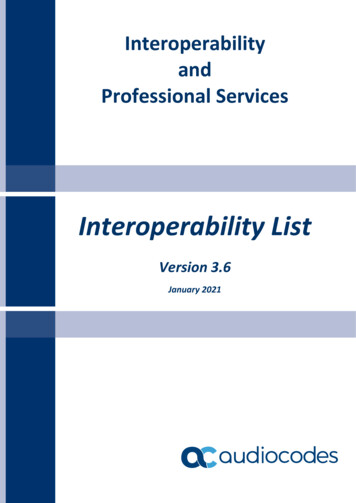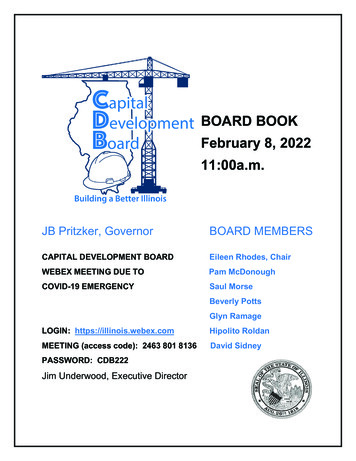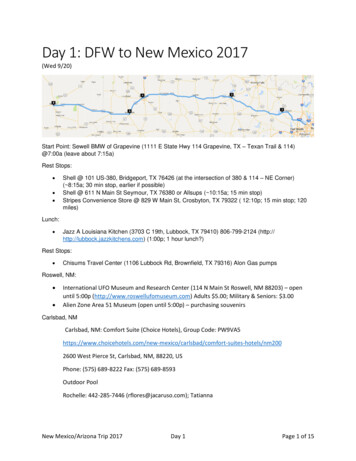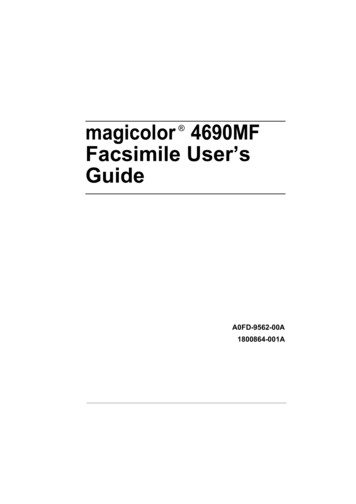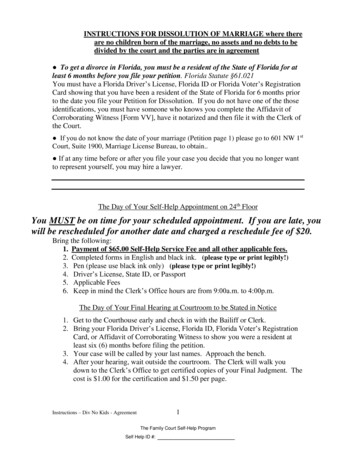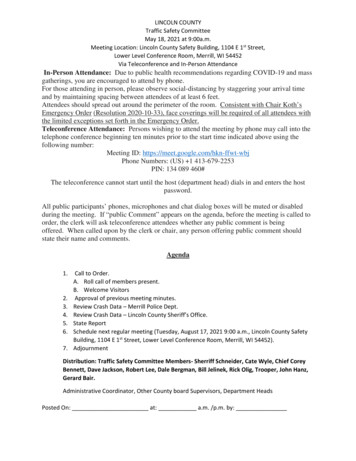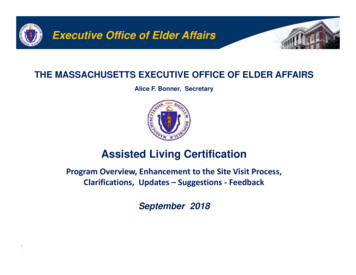
Transcription
00A-L1631-FM 7/3/2001 2:47 PM Page ithe federalist
00A-L1631-FM 7/3/2001 2:47 PM Page iiJames Madison
00A-L1631-FM 7/3/2001 2:47 PM Page iiiJohn Jay
00A-L1631-FM 7/3/2001 2:47 PM Page ivAlexander Hamilton
00A-L1631-FM 7/3/2001 2:47 PM Page vt h e fe de ra l i stbyAlexander Hamilton,John Jay,andJames MadisonThe Gideon EditionEditedwith an Introduction, Reader’s Guide,Constitutional Cross-reference, Index, and GlossarybyGeorge W. CareyandJames McClellanliberty fundIndianapolis
00A-L1631-FM 7/3/2001 2:47 PM Page viThis book is published by Liberty Fund, Inc., a foundation established toencourage study of the ideal of a society of free and responsible individuals.The cuneiform inscription that serves as our logo and as the design motif forour endpapers is the earliest-known written appearance of the word “freedom”(amagi), or “liberty.” It is taken from a clay document written about 2300 B . C .in the Sumerian city-state of Lagash. 2001 Liberty Fund, Inc.Foreword 2001 Liberty Fund, Inc.Frontispiece photographs Corbis-Bettmann05 04 03 02 0105 04 03 02 01cp5 4 3 2 15 4 3 2 1Library of Congress Cataloging-in-Publication DataThe Federalist: a collection/by Alexander Hamilton, John Jay &James Madison; edited with an introduction, reader’s guide, constitutionalcross reference & glossary by George W. Carey, James McClellan.p.cm.“The Gideon edition.”Includes bibliographical references and index.isbn 0-86597-288-5 (alk. paper)isbn 0-86597-289-3 (pbk.: alk. paper)1. United States. Constitution. 2. Constitutional law—United States.I. Hamilton, Alexander, 1757–1804. II. Jay, John, 1745 –1829.III. Madison, James, 1751–1836.IV. Carey, George Wescott, 1933 –V. McClellan, James, 1937–kf4515 .f4 2001342.73 02 — dc2100-051998liberty fund, inc.8335 Allison Pointe Trail, Suite 300Indianapolis, Indiana 46250-1684
00A-L1631-FM 7/3/2001 2:47 PM Page vii“The true distribution of the numbers of the Federalistamong the three writers is . . . the Edition . . . of Gideon. Itwas furnished to him by me, with a perfect knowledge ofits accuracy, as it related to myself, and a full confidence inits equal accuracy as it relates to the two others.”James MadisonUndated MemorandumLibrary of Congress
00A-L1631-FM 7/3/2001 2:47 PM Page viii
00A-L1631-FM 7/3/2001 2:47 PM Page ixContentsEditors’ IntroductionxviiReader’s Guide to The FederalistlviiPreface to the Gideon Editionlxxxvt h e fe d e r a l i s tNo. 1Introduction1No. 2Concerning Dangers from Foreign Force & Influence5No. 3The same Subject continued9No. 4The same Subject continued13No. 5The same Subject continued17No. 6Concerning Dangers from War between the States20No. 7The subject continued, and Particular CausesEnumerated26The effects of Internal War in producing StandingArmies, and other institutions unfriendly to liberty32The Utility of the Union as a Safeguard againstDomestic Faction and Insurrection37No. 10The same Subject continued42No. 11The Utility of the Union in respect to Commerceand a Navy49No. 8No. 9ix
00A-L1631-FM 7/3/2001 2:47 PM Page xContentsNo. 12The Utility of the Union in respect to Revenue55No. 13The same Subject continued, with a view to Economy60No. 14An Objection drawn from the Extent of Country,Answered62Concerning the Defects of the Present Confederation,in Relation to the Principle of Legislation for the Statesin their Collective Capacities68The same Subject continued, in relation to the samePrinciples75The Subject continued, and Illustrated by Examples,to show the tendency of Federal Governments, ratherto Anarchy among the Members, than Tyranny inthe Head80No. 18The Subject continued, with further Examples84No. 19The Subject continued, with further Examples90No. 20The Subject continued, with further Examples95No. 21Further defects of the present Constitution99No. 22The same subject continued, and concluded104No. 23The necessity of a government, at least equally energeticwith the one proposed112The subject continued, with an answer to an objectionconcerning standing armies117No. 25The subject continued, with the same view122No. 26The subject continued, with the same view126No. 27The subject continued, with the same view132No. 28The same subject continued136No. 29Concerning the militia140No. 30Concerning taxation145No. 15No. 16No. 17No. 24x
00A-L1631-FM 7/3/2001 2:47 PM Page xiContentsNo. 31The same subject continued150No. 32The same subject continued154No. 33The same subject continued158No. 34The same subject continued162No. 35The same subject continued167No. 36The same subject continued172No. 37Concerning the difficulties which the convention musthave experienced in the formation of a proper plan179The subject continued, and the incoherence of theobjections to the plan, exposed186The conformity of the plan to republican principles:an objection in respect to the powers of theconvention, examined193No. 40The same objection further examined199No. 41General view of the powers proposed to be vested inthe union207No. 42The same view continued215No. 43The same view continued222No. 44The same view continued and concluded230No. 45A further discussion of the supposed danger from thepowers of the union, to the state governments237The subject of the last paper resumed; with anexamination of the comparative means of influenceof the federal and state governments242The meaning of the maxim, which requires a separationof the departments of power, examined and ascertained249The same subject continued, with a view to the meansof giving efficacy in practice to that maxim256No. 38No. 39No. 46No. 47No. 48xi
00A-L1631-FM 7/3/2001 2:47 PM Page xiiContentsNo. 49The same subject continued, with the same view260No. 50The same subject continued, with the same view264No. 51The same subject continued, with the same view, andconcluded267Concerning the house of representatives, with a viewto the qualifications of the electors and elected, and thetime of service of the members272The same subject continued, with a view of the termof service of the members276The same subject continued, with a view to the ratioof representation282The same subject continued, in relation to the totalnumber of the body286No. 56The subject continued, in relation to the same point291No. 57The same subject continued, in relation to the supposedtendency of the plan of the convention to elevate thefew above the many295The same subject continued, in relation to the futureaugmentation of the members300No. 59Concerning the regulation of elections305No. 60The same subject continued310No. 61The same subject continued, and concluded315No. 62Concerning the constitution of the senate, with regardto the qualifications of the members; the manner ofappointing them; the equality of representation; thenumber of the senators, and the duration of theirappointments319A further view of the constitution of the senate, inregard to the duration of the appointment of itsmembers325No. 52No. 53No. 54No. 55No. 58No. 63xii
00A-L1631-FM 7/3/2001 2:47 PM Page xiiiContentsNo. 64A further view of the constitution of the senate, inregard to the power of making treaties332A further view of the constitution of the senate, inrelation to its capacity, as a court for the trial ofimpeachments337No. 66The same subject continued342No. 67Concerning the constitution of the president: a grossattempt to misrepresent this part of the plan detected347The view of the constitution of the presidentcontinued, in relation to the mode of appointment351The same view continued, with a comparison betweenthe president and the king of Great Britain, on the onehand, and the governor of New York, on the other355The same view continued, in relation to the unity ofthe executive, and with an examination of the projectof an executive council362The same view continued, in regard to the duration ofthe office369The same view continued, in regard to the re-eligibilityof the president374The same view continued, in relation to the provisionconcerning support, and the power of the negative379The same view continued, in relation to the commandof the national forces, and the power of pardoning384The same view continued, in relation to the power ofmaking treaties387The same view continued, in relation to theappointment of the officers of the government391No. 65No. 68No. 69No. 70No. 71No. 72No. 73No. 74No. 75No. 76No. 77The view of the constitution of the president concluded,with a further consideration of the power of appointment,and a concise examination of his remaining powers396xiii
00A-L1631-FM 7/3/2001 2:47 PM Page xivContentsNo. 78A view of the constitution of the judicial departmentin relation to the tenure of good behaviour401A further view of the judicial department, in relationto the provisions for the support and responsibilityof the judges408A further view of the judicial department, in relationto the extent of its powers411A further view of the judicial department, in relationto the distribution of its authority417A further view of the judicial department, in referenceto some miscellaneous questions426A further view of the judicial department, in relationto the trial by jury430No. 84Concerning several miscellaneous objections442No. 85Conclusion452Glossary459No. 79No. 80No. 81No. 82No. 83Appendixes1. The Declaration of Independence4952. Articles of Confederation5003. Virginia Resolution Proposing the AnnapolisConvention5104. Proceedings of the Annapolis Convention5115. Virginia Resolution Providing Delegates to the FederalConvention of 17875166. Call by the Continental Congress for the FederalConvention of 1787518xiv
00A-L1631-FM 7/3/2001 2:47 PM Page xvContents7. Resolution of the Federal Convention Submitting theConstitution to the Continental Congress5208. Washington’s Letter of Transmittal to the President ofthe Continental Congress5229. Resolution of the Continental Congress Submittingthe Constitution to the Several States52410. Letter of the Secretary of the Continental CongressTransmitting Copy of the Constitution to the SeveralGovernors525The Constitution of the United States (cross-referencedwith The Federalist) and Amendments526Index553xv
00A-L1631-FM 7/3/2001 2:47 PM Page xvi
00B-L1631-INT 7/3/2001 2:47 PM Page xviiEditors’ IntroductionThe American Constitution is the oldest written national constitution in theworld.1 Its durability and veneration over the years would seem to affirmThomas Jefferson’s estimate that the fundamental law of the American people“is unquestionably the wisest ever yet presented to men.” 21. But the oldest written constitution still in force is the Massachusetts Constitution of1780. The first written constitutions were the State constitutions adopted in 1776. See note13, infra. The first national constitution to appear in a single document was the Articlesof Confederation (1777). The American Constitution came a decade later. The third national constitution was promulgated in Poland on May 3, 1791; the fourth was the FrenchConstitution of September 3, 1791. The two European constitutions sought to establish aconstitutional monarchy, but neither lasted even two years. The British Constitution isthe oldest among nations, dating back at least as far as the Magna Charta (1215); but itis “unwritten” in the sense that it is not limited to a single document. It consists, rather, offundamental principles of free government drawn from a complex maze of parliamentarystatutes, common law judicial precedents, and ancient political customs or conventions.See A. V. Dicey, Introduction to the Study of the Law of the Constitution (Indianapolis:Liberty Fund, 1982).2. Thomas Jefferson to David Humphreys, March 18, 1789, in Papers of Thomas Jefferson, ed. Julian Boyd (Princeton: Princeton University Press, 1958), 14: 678. “[T]his is thebest Government that has ever yet been offered to the world,” said Charles Pinckney ofSouth Carolina in 1788, “and instead of being alarmed at its consequences we should beastonishingly pleased that one so perfect could have been formed from discordant andunpromising materials.” (Jonathan Elliot, ed., The Debates in the Several State Conventionson the Adoption of the Federal Constitution [Philadelphia: J. B. Lippincott, 1836], IV: 261).Pinckney served as a delegate to both the Federal Convention and the South Carolinaratifying convention. For contemporaneous views on the Constitution among leaders ofthe founding generation, see Charles Warren, The Making of the Constitution (Cambridge:Harvard University Press, 1928), 733 –782. “Let us look to America,” advised Alexis deTocqueville, “let us borrow from her the principles . . . of order, of the balance of powers,of true liberty, of deep and sincere respect for right [which] are indispensable to all republics.” (author’s preface to the 12th ed., 1848, Democracy in America [New York: AlfredKnopf, 1948], cvi– cvii). The British statesman William Gladstone described the AmericanConstitution as “the most remarkable work known to me in modern times to have beenproduced by the human intellect.” (quoted in Albert P. Blaustein, The Influence of thexvii
00B-L1631-INT 7/3/2001 2:47 PM Page xviiiEditors’ IntroductionAt the time of its adoption, however, Americans were deeply divided overits merits. When the delegates to the Federal Convention of 1787 completedtheir work in Philadelphia and voted on September 17 to approve the newConstitution and submit it to the people in the several States for ratification,three leading members of the convention—Edmund Randolph and GeorgeMason of Virginia, and Elbridge Gerry of Massachusetts—refused to sign.Others simply left the convention before the proceedings ended. Of the fiftyfive delegates who actually attended the convention, only thirty-nine affixedtheir signatures to the final draft.No less disconcerting was the fact that a number of influential politicalleaders, including Patrick Henry, Richard Henry Lee, and James Monroe ofVirginia, Samuel Adams and John Hancock of Massachusetts, and John Jayand Governor George Clinton of New York, had either boycotted the convention or were excluded from it. At least some of them could now be expected to oppose or lead the fight against ratification.Moreover, the nation’s two most experienced constitutional architects,John Adams of Massachusetts and Thomas Jefferson of Virginia, both ofthem leaders of pivotal states in the ratification struggle and warm supporters of the new Constitution, were on diplomatic assignment in Europe. Thus,they could not participate in the convention’s deliberations or in the publicdebates over ratification. They nevertheless corresponded with friends backhome and with each other, readily exchanging views on the Constitution’sstrengths and weaknesses. “We agree perfectly,” Adams wrote Jefferson, “thatthe many should have a full, fair, and perfect representation. You are apprehensive of Monarchy, I of Aristocracy. I would therefore have given morePower to the President and less to the Senate.” 3 A few of the Framers alsoUnited States Constitution Abroad [Washington, D.C.: Washington Institute for Values inPublic Policy, 1986], 32). With few exceptions, contends Blaustein, “every nation that hasa one-document constitution (or is committed in principle to having one) is inevitablyfollowing the United States precedent-model” (Ibid., 7). We are reminded, however, that“Of the many systems of free and popular government in operation in the world today,there are few, if any, which do not bear, in a variety of features, the unmistakable marksof derivation from the Constitution of England in some stage of its development from1688 to the present day.” (Maurice Amos, The English Constitution [London: Longmans,Green, 1930], 14).3. John Adams to Thomas Jefferson, December 6, 1787, in The Works of John Adams,ed. Charles Francis Adams (Boston: Little Brown, 1853), VII: 464. Adams was respondingto Jefferson’s letter of November 13, in which Jefferson had indicated that he would havexviii
00B-L1631-INT 7/3/2001 2:47 PM Page xixEditors’ Introductionsolicited the opinions of Adams and Jefferson. James Madison of Virginia,for example, corresponded regularly with Jefferson, and Roger Sherman ofConnecticut exchanged views with Adams on a number of constitutionalpoints. Adams told Jay at the outset of the ratification struggle that “the public mind cannot be occupied about a nobler object than the proposed plan ofgovernment. It appears to be admirably calculated to cement all America inan affectation and interest, as one great nation.” Like so many friends of theConstitution, Adams acknowledged its imperfections but accepted the newConstitution as probably the best compromise possible under the circumstances. “A result of accommodation and compromise cannot be supposedperfectly to coincide with everyone’s idea of perfection,” he reminded Jay.“But, as all the great principles necessary to order, liberty, and safety are respected in it, and provision is made for corrections and amendments as theymay be found necessary, I confess I hope to hear of its adoption by all thestates.” 4t h e m o v e m e n t t o wa r d c o n s t i t u t i o n a l r e f o r mThe Framers of the American Constitution confronted three major tasks.The first was to improve the relationship among the States, or to create “amore perfect union.” The second was to design a federal government withlimited, delegated, and enumerated powers sufficient to govern effectively,reserving to the States and the people thereof those powers not delegated,in order to protect their rights and liberties and prevent the central government from usurping them. The third task was to implement the principle of“government by consent” and to confer legitimacy upon the new government by building it upon a solid foundation of popular sovereignty, withbeen content to add “three or four new articles . . . to the good, old and venerable fabric[i.e., the Articles of Confederation], which should have been preserved even as a religiousrelic.” In particular, he favored giving the Senate a stronger voice in both foreign and domestic affairs, and limiting the President to a single term. “How do you like our new Constitution?” queried Jefferson. “Their President seems a bad edition of a Polish king. Hemay be reelected from 4 years to 4 years for life. Reason and experience prove to us that achief magistrate, so continuable, is an officer for life.” (Jefferson, Papers, 12: 350 –351). Jefferson’s concern was addressed more than a century later when in 1951 the States ratifiedthe 22nd Amendment to the Constitution, thereby constitutionalizing the custom established by George Washington for limiting the President to two terms.4. John Adams to John Jay, December 16, 1787, in Works of John Adams, VIII: 467.xix
00B-L1631-INT 7/3/2001 2:47 PM Page xxEditors’ Introductionout sacrificing the sovereignty of the States that agree to join the Union.How the Framers accomplished these objectives is the story of the Americanfounding.The Federal, or Philadelphia, Convention, as it is sometimes called, wasthe culmination of a struggle dating back to the American Revolution to provide central direction to American affairs and promote closer cooperationamong the then-thirteen colonies. Even before the outbreak of armed hostilities, colonial leaders had recognized the importance of coordinated opposition to British domination, as witnessed by the convening of the Stamp ActCongress in 1765 to challenge the constitutionality of the Act, and the formation between 1772 and 1774 of intercolonial Committees of Correspondenceto exchange information and unite the colonies against George III and theBritish Parliament.These efforts laid the groundwork for concerted action that led directlyto the creation of the first Continental Congress in 1774. This remarkablebody sat for fifteen years, first in Carpenters’ Hall in Philadelphia and later ina number of other cities, completing its final session in New York City in 1788.Though regarded at first as only a temporary assembly, the Continental Congress met for seven years (1774 –1781) before its powers were ever clearly defined. During this period, it exercised many of the powers of a sovereign state,such as declaring the independence of the United States, issuing currency,borrowing large sums of money, entering into an alliance with France, building a navy, and raising an army. It also drafted America’s first instrument ofgovernment, styled “The Articles of Confederation and Perpetual Union.”Described as a “league of friendship” among the thirteen States, each retaining “its sovereignty, freedom and independence,” the Articles of Confederation were more like a treaty than a genuine constitution delineating the powers and functions of a central government. The document made no provisionfor an executive or a judiciary branch, and the member States retained mostof their original powers. Not the least disconcerting was the failure of the Articles to confer supremacy on the Confederation’s laws and treaties, therebyrendering them equal to State constitutions and statutes and making themunenforceable when a State refused to comply.As early as July 1775 the need for Articles of Confederation was discussedin Congress, and a plan for them was presented by Benjamin Franklin. Butno action was taken until June 7, 1776, when Richard Henry Lee offered axx
00B-L1631-INT 7/3/2001 2:47 PM Page xxiEditors’ Introductionresolution providing that: (1) “these United Colonies are, and of right oughtto be, free and independent States”; (2) that alliances should be made fortheir protection; and (3) that “a plan of confederation be prepared and transmitted to the respective colonies.” 5 On June 11, a committee consisting ofThomas Jefferson, Benjamin Franklin, John Adams, Robert Livingston, andRoger Sherman was appointed to prepare a Declaration of Independence. Asecond committee, headed by John Dickinson of Delaware, was appointeda day later to draft the Articles of Confederation. After extended debate andconsiderable delay, the Articles were formally adopted on November 15, 1777,and sent to each State legislature for ratification. Because the Articles requiredthe unanimous consent of all the States before they could go into effect, therewere further delays. Some of the small States, especially Maryland, refused tosign until the larger States surrendered their claims to territory in the Northwest. Consequently, the Articles did not go into effect until Virginia offeredto cede her claims to the Union in 1781. What is more, by defining the powers of the Continental Congress the Articles necessarily limited them; actionspreviously thought appropriate were now denied.Throughout its relatively brief existence, which ended in 1789 when thesystem created by the Philadelphia Convention was put into operation, therewas widespread dissatisfaction with the Articles, principally because theyconferred so little power on the Continental Congress. Indeed, in 1780, evenbefore ratification was complete, Alexander Hamilton anticipated the difficulties that would arise and urged political leaders to call a convention ofthe States to draft plans for a far stronger confederation. A short time later,in 1781, writing under a pen name, “The Continentalist,” he again arguedthat “we ought without delay to enlarge the powers of Congress.” 6 In 1780, a5. Pauline Maier, American Scripture: Making the Declaration of Independence (NewYork: Alfred Knopf, 1997), 41. Lee was instructed by the Virginia Convention of 1776 tooffer the resolution, and it was seconded by John Adams.6. Alexander Hamilton, “The Continentalist No. 3,” August 9, 1781, in The Papers ofAlexander Hamilton (New York: Columbia University Press, 1961), II: 665. Hamilton wrotesix essays under the pseudonym of The Continentalist, dated July 12, August 9 and 30,1781; and April 18 and July 4, 1782. “As too much power leads to despotism,” declaredHamilton, “too little leads to anarchy, and both eventually to the ruin of the people.”(“The Continentalist No. 1,” Ibid., 651). The inherent weakness of earlier confederations,especially those of ancient Greece, served as a warning to the American people: decrees ofthe Amphictyonic Council became ineffectual, and “when the cities were not engaged inxxi
00B-L1631-INT 7/3/2001 2:47 PM Page xxiiEditors’ Introductionconvention of New England States meeting in Boston proposed that theAmerican States immediately form a “more solid union” than that providedby the Articles. In 1781 and 1782, the New York Assembly recommended “ageneral convention of the States specially authorized to revise and amend theConfederation.” 7Responding to these appeals, the Continental Congress tried, withoutsuccess, to amend the Articles and enlarge its powers. In February 1781, forexample, Congress proposed an amendment authorizing the Confederationgovernment to levy a five percent ad valorem duty to raise revenue. Twelvestates agreed, but Rhode Island opposed the change, and because of the unanimity requirement the amendment failed. A month later James Madisonrecommended that Congress be given authority to employ the force of theUnited States to “compel [the] States to fulfill their federal engagements,”but no action was taken.8 Again, that same year a committee of the Congressreported twenty-one deficiencies in the Articles and recommended a general enlargement of Congress’s powers, but without success. As late as 1786,Charles Pinckney of South Carolina was leading an effort in the Congressto call a constitutional convention, but to no avail.The Continental Congress, it became clear, had reached an impasse. Inpractice, the unanimity requirement rendered it virtually impossible toforeign wars, they were at perpetual variance among themselves. Sparta and Athens contended twenty-seven years for . . . dominion of Greece,” and as a result the Macedoniansand eventually the Romans “became their masters.” (“The Continentalist No. 2,” Ibid.,656). Hamilton would later invoke this and other historical examples of failed confederacies in The Federalist. Madison shared his aversion to confederacies, noting in FederalistNo. 18 “the tendency of federal bodies, rather to anarchy among its members, than totyranny in the head.” The solution for saving the Articles, Hamilton explained in the lastthree “Continentalist” essays, was to give Congress more power, including that of regulating trade, levying land and capitation taxes, and appointing its own officers of the customs, collectors of taxes, and military officers.7. George Bancroft, History of the Formation of the Constitution (New York: Appleton,1883), I: 39. Bancroft and others have speculated that Alexander Hamilton was probablythe author of these resolutions.8. Madison’s proposed amendment of March 12, 1781, is reprinted in The Papers ofJames Madison, ed. by William T. Hutchinson and William M. E. Rachel (Chicago: University of Chicago Press, 1963), III: 17–19. Public-spirited individuals outside the government expressed similar concerns about the defects of the Articles. See, for example,Pelatiah Webster, A Dissertation on the Political Union and Constitution of the ThirteenUnited States (1783), and Noah Webster, Sketches of American Policy (1785).xxii
00B-L1631-INT 7/3/2001 2:47 PM Page xxiiiEditors’ Introductionamend the document even if an overwhelming majority of the States favoredchange. The inability to act on these provisions necessarily doomed the Articles of Confederation to extinction, because the Continental Congress washelpless to correct flaws in the system or to adapt it to changing circumstances.9 During the final eight years of its existence, the Congress thus grewweaker and weaker until at last many political leaders reached the conclusionthat a new, more efficient and more powerful government was needed. It became clear, however, that if a workable constitutional system responsive tothe needs of the American people were to be established, the impetus wouldhave to come from outside the Congress.10c o n s t i t u t i o n a l r e f o r m i n t h e s tat e sIn the meantime, the colonies had already transformed themselves into thirteen constitutional republics, each claiming independence, sovereignty, andstatehood. They had progressed to this stage of political development overa two-year period beginning with the creation of the Committees of Correspondence in 1772. These bodies were subsequently replaced by revolutionary or provincial legislatures in each colony, such as the Provincial Congress in Massachusetts and the Provincial Conventions in Maryland and theCarolinas. Many members of these transitional legislative bodies had served9. Because the Articles of Confederation proved inadequate in some respects and hadto be replaced by a new frame of government, it has been fashionable, as one historiannotes, to criticize it harshly, and even heap scorn upon it. But “whatever the defects of theArticles of Confederation, they constitute nevertheless an important, a necessary stagein the development of an efficient constitution . . . [just] as the Confederation under themwas an important, a necessary step in the program toward a more perfect union.” (Edmund Cody Burnett, The Continental Congress [New York: Norton, 1964], 257). To be sure,under the Articles the Treaty of Peace acknowledging American independence was negotiated, the war of the Revolution was concluded, and a Union of States was established. Formany Americans, a decentralized confederation in which public affairs were entrustedlargely to State and local officials was preferable to a consolidated Union run by a distantgovernment. To a very great extent, whether the Articles were a success or a failure is aquestion that depends on one’s philosophy of government and view of the public interest.10. “There was a good deal of truth in what John Adams once said of it,” noted the historian John Fiske, that the Continental Congress “was more a diplomatic than a legislativebody. I
No. 31 The same subject continued 150 No. 32 The same subject continued 154 No. 33 The same subject continued 158 No. 34 The same subject continued 162 No. 35 The same subject continued 167 No. 36 The same subject continued 172 No. 37 Concerning the difficulties which the convention must have experienced in the formation of a proper plan 179 No. 38 The subject continued, and the incoherence of the
